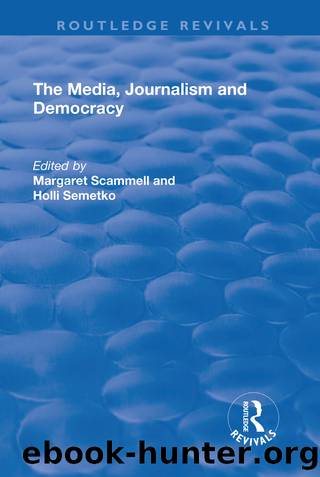The Media, Journalism and Democracy by Margaret Scammell & Holli Semetko

Author:Margaret Scammell & Holli Semetko [Scammell, Margaret & Semetko, Holli]
Language: eng
Format: epub
Tags: Political Science, Political Process, General
ISBN: 9781351747103
Google: FFJHDwAAQBAJ
Goodreads: 38810524
Publisher: Routledge
Published: 2018-01-17T00:00:00+00:00
Graph 1. Political position and notion of objectivity.
Graph 2. Impartiality and "Hard Facts" notion of objectivity.
Graph 3. Relationship between notion and importance of objectivity.
Graph 4. Age and importance of objectivity.
Graph 5. Impartiality and importance of objectivity.
Graph 6. Relationship between dissonance and evaluation of news organization's objectivity.
percent among the conservative). Overall and as a confirmation of what we found for the different age groups, we can conclude that the notions of objectivity seem to be quite unaffected by other variables in U.S. and British journalism while they vary substantially in continental-European countries.
However, another variable affects a journalist's notion of objectivity similarly in all four countries: his or her attitude towards the role of the news media. We asked our respondents to what degree they would prefer a more impartial news system where each individual news organization presents a balanced version of all significant viewpoints, or an advocacy system where each news organization promotes its own particular point of view.6 In all countries, the majority of journalists favored the impartial news system. However, there were differences in the degree to which they supported this view of the role of the mass media.7
For the purpose of the context in this paper we distinguished between respondents who were strong supporters of the impartiality system (scale point 1) and those who tended more or less to the advocacy news system (scale points 2 through 7) and compared their answers on their notion of objectivity.
Graph 2 shows the respective relationships for the "Hard Facts" model of objectivity. We find an unanimous and clear correlation in all four countries for the "Hard Facts" model: Journalists who are less inclined with the impartiality role model are more in favor of an objectivity model that goes beyond statements and strives to find 'true reality'. Between-group differences are in the range of 11 to 12 percentage points for all countries. From this, we can infer that "going to the hard facts of a political dispute" is usually combined with advocating a particular point of view, not necessarily with presenting the (negative and positive) hard facts of all contending sides in a political conflict.
Download
This site does not store any files on its server. We only index and link to content provided by other sites. Please contact the content providers to delete copyright contents if any and email us, we'll remove relevant links or contents immediately.
The Secret History by Donna Tartt(18861)
The Social Justice Warrior Handbook by Lisa De Pasquale(12143)
Thirteen Reasons Why by Jay Asher(8800)
This Is How You Lose Her by Junot Diaz(6803)
Weapons of Math Destruction by Cathy O'Neil(6152)
Zero to One by Peter Thiel(5692)
Beartown by Fredrik Backman(5609)
The Myth of the Strong Leader by Archie Brown(5429)
The Fire Next Time by James Baldwin(5253)
How Democracies Die by Steven Levitsky & Daniel Ziblatt(5133)
Promise Me, Dad by Joe Biden(5089)
Stone's Rules by Roger Stone(5028)
A Higher Loyalty: Truth, Lies, and Leadership by James Comey(4851)
100 Deadly Skills by Clint Emerson(4845)
Rise and Kill First by Ronen Bergman(4705)
Secrecy World by Jake Bernstein(4652)
The David Icke Guide to the Global Conspiracy (and how to end it) by David Icke(4629)
The Farm by Tom Rob Smith(4442)
The Doomsday Machine by Daniel Ellsberg(4420)
